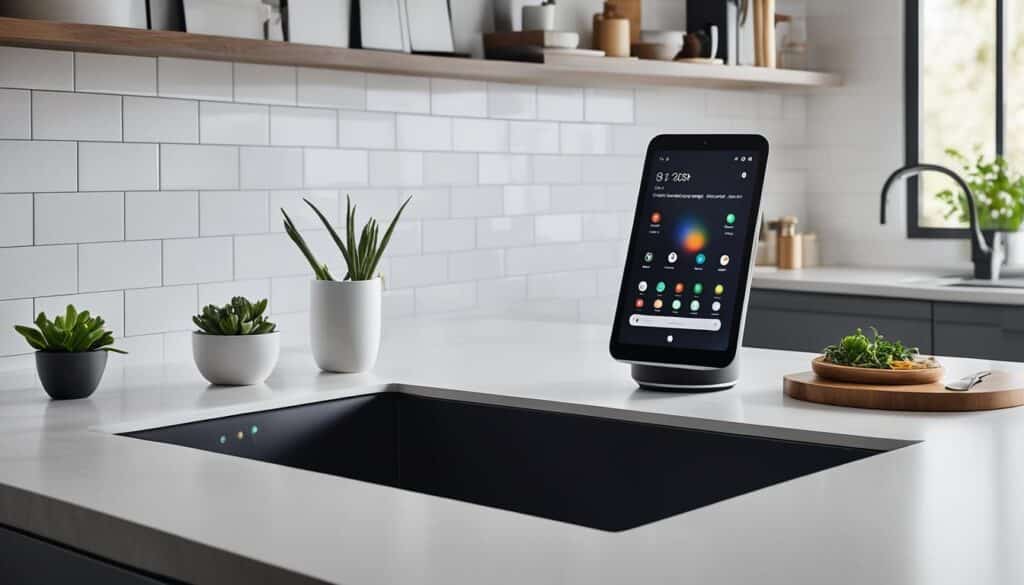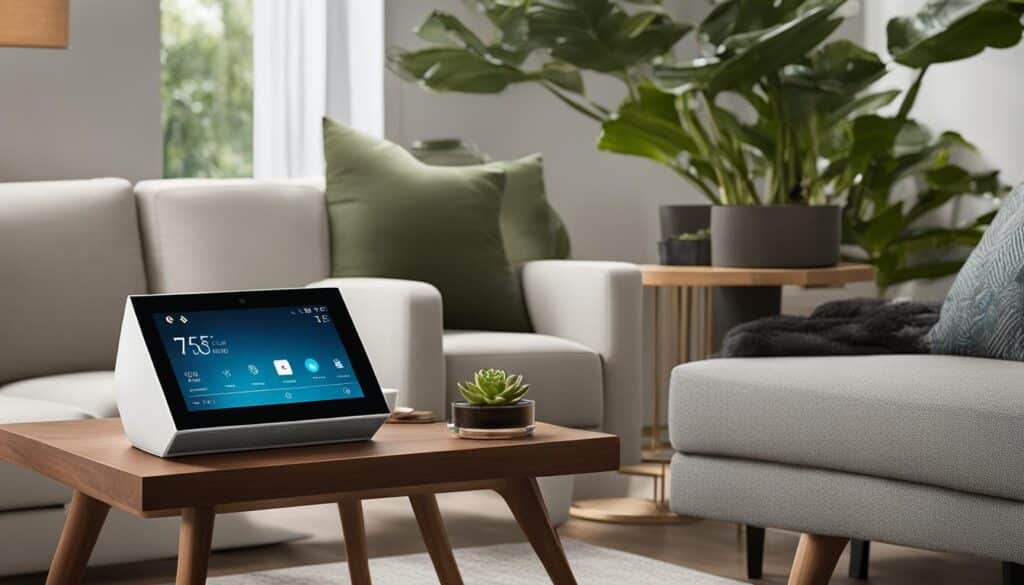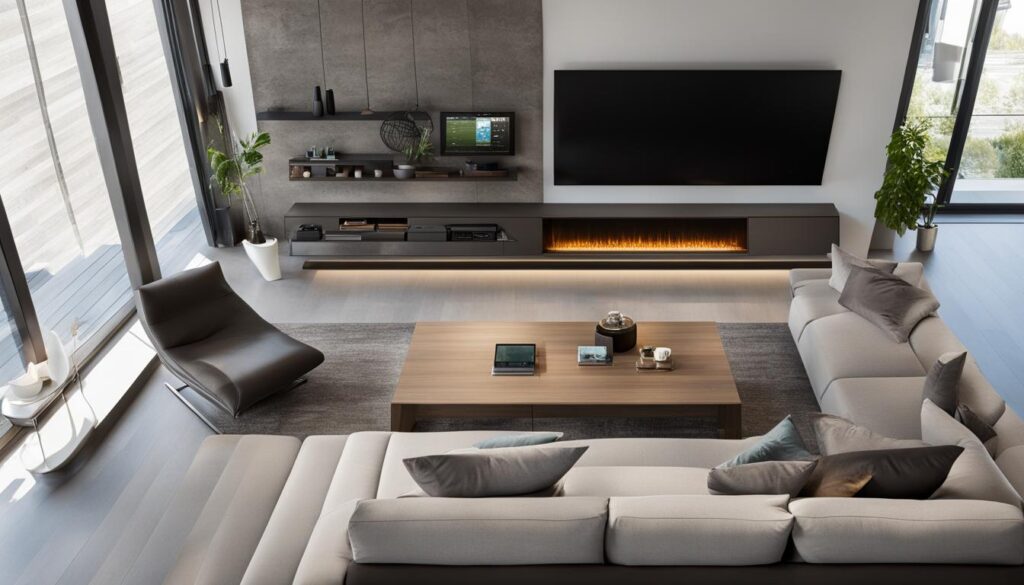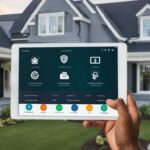When it comes to creating a smart home, one key component that beginners should familiarize themselves with is the smart home control panel. This device acts as the central hub for managing and controlling all the smart devices in your home, making it easier for you to automate and personalize your living space. In this beginner’s guide, let’s explore what smart home control panels are and why they are essential for a seamless home automation setup.
Table of Contents
Key Takeaways:
- Smart home control panels are devices that provide a centralized interface for managing and controlling smart devices in your home.
- They allow you to easily access and control various aspects of your smart home, such as lighting, security systems, thermostats, and more.
- Popular brands of smart home control panels include Google Nest Hub, Amazon Echo Show, and Samsung SmartThings Hub.
- Setting up a smart home control panel involves ensuring compatibility with your existing devices and connecting it to your Wi-Fi network.
- The convenience and efficiency offered by smart home control panels simplify the automation and management of your smart home, enhancing your overall experience.
What Are Smart Home Control Panels?
Smart home control panels are devices that provide a user interface for controlling and managing smart home devices and systems. They serve as a centralized hub for homeowners to effortlessly monitor and control various aspects of their smart home setup. With a combination of user-friendly features and advanced functions, these control panels enhance convenience, efficiency, and overall home automation experience.
Typically, smart home control panels consist of a touchscreen display, physical buttons, and connectivity options such as Wi-Fi or Bluetooth. This allows users to interact with the panel through intuitive touch controls or physical buttons for quick and easy access to essential home automation functions. Additionally, these panels give homeowners the flexibility to connect and control a wide range of devices, including lighting, heating and cooling systems, security systems, entertainment systems, and more.
By providing a centralized control point, smart home control panels eliminate the need to navigate through multiple apps or physical controls to manage different devices. They offer a seamless and streamlined user experience, allowing homeowners to monitor and control their smart home devices from one convenient location. Whether it’s adjusting the lighting, setting the temperature, or checking the security cameras, these panels offer a comprehensive solution for managing a smart home.
Some common features and functions of smart home control panels include:
- Monitoring and controlling lighting, allowing users to adjust brightness, color, and scheduling.
- Controlling heating and cooling systems, enabling users to set and automate temperature settings for optimal comfort and energy efficiency.
- Managing security systems, providing access to video feeds, motion detection settings, and alarm controls.
- Controlling entertainment systems, allowing users to play music, stream videos, and adjust volume levels.
- Integrating with voice assistants, such as Amazon Alexa or Google Assistant, to enable hands-free control through voice commands.
Overall, smart home control panels are essential devices that simplify the management and control of various smart home devices and systems. They offer a user-friendly interface, versatile connectivity options, and a centralized control point for effortless home automation. With the ability to access and manage multiple devices from one location, homeowners can enhance the convenience, efficiency, and overall functionality of their smart homes.
Types of Smart Home Control Panels
When it comes to smart home control panels, there is a wide range of options available on the market. These control panels come in various types and are offered by popular brands such as Google, Amazon, and Samsung. Let’s take a closer look at the different types of control panels and what they have to offer.
1. Google Nest Hub

The Google Nest Hub is a versatile smart home control panel that combines a touchscreen display with the power of Google Assistant. With this control panel, you can easily control your smart devices using voice commands or through the intuitive interface. It also acts as a digital photo frame, displaying your favorite memories when not in use.
2. Amazon Echo Show

The Amazon Echo Show is another popular choice for smart home control panels. It features a vibrant screen and is powered by Amazon Alexa, allowing you to control your smart home devices effortlessly. You can also use it to watch videos, stream music, and even make video calls.
3. Samsung SmartThings Hub
The Samsung SmartThings Hub offers a comprehensive control solution for your smart home. It supports a wide range of devices and protocols, giving you the flexibility to connect and control multiple brands and types of smart devices. With its advanced features like facial recognition and gesture control, it takes home automation to the next level.
These are just a few examples of the types of smart home control panels available. Each brand and model comes with its own unique set of features and capabilities, allowing you to choose the control panel that best suits your needs and preferences.
When selecting a control panel, consider factors such as the size, design, integration with voice assistants, and additional features like facial recognition or gesture control. By exploring the different options, you can find the perfect smart home control panel to enhance your home automation experience.
Setting Up a Smart Home Control Panel
Setting up a smart home control panel involves a few key steps that ensure a seamless integration with your existing smart home devices. Here’s a step-by-step guide to get you started:
- Check compatibility: Before beginning the installation process, it’s crucial to ensure that your control panel is compatible with your existing smart home devices. This requires checking for compatibility with specific protocols like Z-Wave or Zigbee. Compatibility ensures smooth communication and interaction between your control panel and other devices.
- Connect to Wi-Fi: Once compatibility is confirmed, the next step is to connect your control panel to your home’s Wi-Fi network. This allows the panel to access the internet and enables remote control from your smartphone or other devices.
- Link smart devices: After connecting to Wi-Fi, it’s time to link your desired smart devices with the control panel. This process may vary depending on the brand and model of your control panel. Generally, it involves following on-screen prompts and using a companion app to search for and connect to your smart devices.
- Configure settings: Once your smart devices are linked, you can proceed to configure and customize the settings of your control panel. This includes personalizing preferences, setting up automation routines, and fine-tuning controls to suit your specific needs and lifestyle.
Setting up your smart home control panel is crucial for maximizing its functionalities and enjoying a seamless smart home experience. By following these steps, you’ll be well on your way to creating a centralized control hub that simplifies the management of your smart devices.
Benefits of Smart Home Control Panels
Smart home control panels offer several advantages that greatly enhance the convenience and efficiency of managing a smart home. By centralizing the control of various devices and systems, homeowners can experience a seamless and streamlined smart home experience.
One of the main advantages of smart home control panels is the convenience they provide. With a centralized control hub, homeowners no longer need to navigate through multiple apps or physical controls to manage different functions. Instead, they can access and control all their smart devices from one user-friendly interface.
By simplifying the process of controlling and monitoring smart home devices, control panels make it more convenient for homeowners to manage their smart home systems. Whether it’s adjusting the lighting, setting the thermostat, or arming the security system, everything can be easily controlled with just a few taps on the control panel’s touchscreen display.
In addition to convenience, smart home control panels also contribute to energy efficiency. These panels allow homeowners to effortlessly adjust and automate various settings such as lighting and heating based on their preferences or occupancy patterns. With the ability to easily customize and program these settings, homeowners can optimize their energy usage and reduce waste.
Smart home control panels provide a centralized hub for managing and controlling various devices, offering convenience, efficiency, and energy savings.
Overall, smart home control panels offer a range of benefits that make managing a smart home more convenient and efficient. By providing a centralized control hub, these panels eliminate the need for multiple apps or physical controls, simplifying the management process. Additionally, homeowners can optimize their energy usage and reduce waste with the ability to adjust and automate various settings. With the advantages they offer, smart home control panels are an essential component for any modern smart home.
Ways Smart Home Control Panels Enhance Convenience:
- Centralized control hub for all smart devices
- User-friendly interface for easy control and monitoring
- Simplified adjustment and automation of settings
Benefits of Smart Home Control Panels:
- Convenience of centralized control
- User-friendly interface for easy management
- Energy efficiency through optimized settings
Conclusion
In summary, smart home control panels are essential for beginners who want to simplify their home automation setup and enhance their smart home experience. These panels serve as a centralized hub for managing and controlling a variety of smart devices and systems. By choosing the right control panel, setting it up properly, and exploring its features, homeowners can improve the convenience, efficiency, and overall functionality of their smart home.
With the help of smart home control panels like Google Nest Hub, Amazon Echo Show, or Samsung SmartThings Hub, beginners can dive into the world of home automation with confidence and ease. These panels offer user-friendly interfaces, allowing homeowners to easily access and control multiple smart devices from one location. With just a few taps on the touchscreen display or voice commands to integrated assistants such as Google Assistant or Amazon Alexa, users can adjust lighting, manage security systems, control entertainment systems, and more.
By centralizing control over their smart home devices, homeowners can enjoy the convenience of managing their entire smart home ecosystem from a single panel. This eliminates the need to navigate through multiple apps or physical controls, saving time and effort. Additionally, control panels offer advanced features such as facial recognition and gesture control, further enhancing the user experience.
In conclusion, smart home control panels are a valuable addition to any smart home setup. They make it easier for beginners to navigate the world of home automation and enjoy the benefits of a connected home. With their ability to streamline control and provide a centralized hub, smart home control panels contribute to a more convenient, efficient, and enjoyable smart home experience.
FAQ
What is a smart home control panel?
A smart home control panel is a device that provides a user interface for controlling and managing smart home devices and systems. It serves as a centralized hub for connecting and controlling smart devices such as lighting, thermostats, security systems, and more.
What are the features and functions of a smart home control panel?
Smart home control panels typically consist of a touchscreen display, physical buttons, and connectivity options such as Wi-Fi or Bluetooth. They offer the ability to monitor and control lighting, heating and cooling, security systems, entertainment systems, and more. They provide a centralized control point, allowing homeowners to easily access and manage their smart home devices from one location.
What are some popular brands of smart home control panels?
Popular brands of smart home control panels include Google Nest Hub, Amazon Echo Show, and Samsung SmartThings Hub. These panels vary in size, design, and functionality. Some are integrated with voice assistants like Google Assistant or Amazon Alexa, allowing users to control their smart home devices through voice commands. Others offer more advanced features such as facial recognition and gesture control.
How do I set up a smart home control panel?
To set up a smart home control panel, ensure that it is compatible with your existing smart home devices. Check for compatibility with specific protocols such as Z-Wave or Zigbee. Once compatibility is confirmed, connect the control panel to your home’s Wi-Fi network and link it to the desired smart devices. The setup process typically involves following on-screen prompts and using a companion app to configure and customize the control panel’s settings.
What are the benefits of using a smart home control panel?
Smart home control panels offer several benefits to homeowners. One of the main advantages is the convenience of having a centralized control hub for all smart devices, eliminating the need to navigate through multiple apps or physical controls. These panels provide a user-friendly interface that simplifies the process of controlling and monitoring smart home devices. They can also increase energy efficiency by allowing homeowners to easily adjust and automate settings such as lighting and heating based on their preferences or occupancy patterns.


